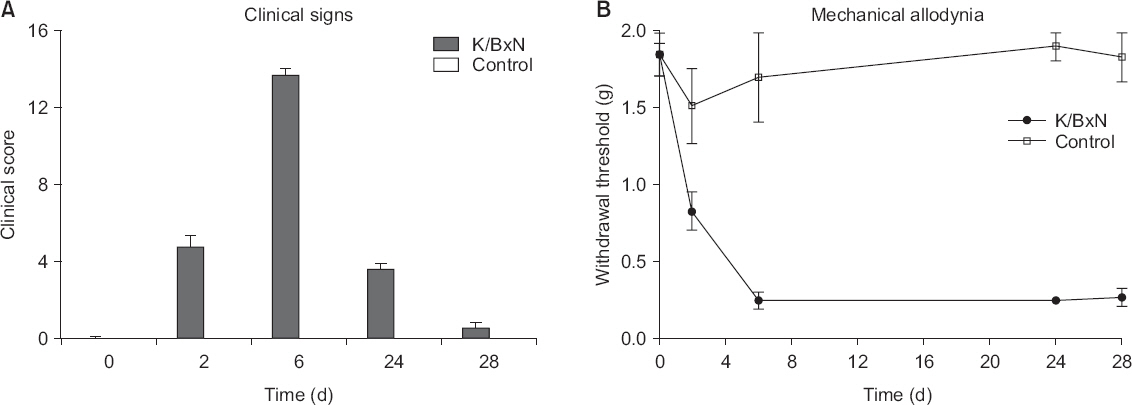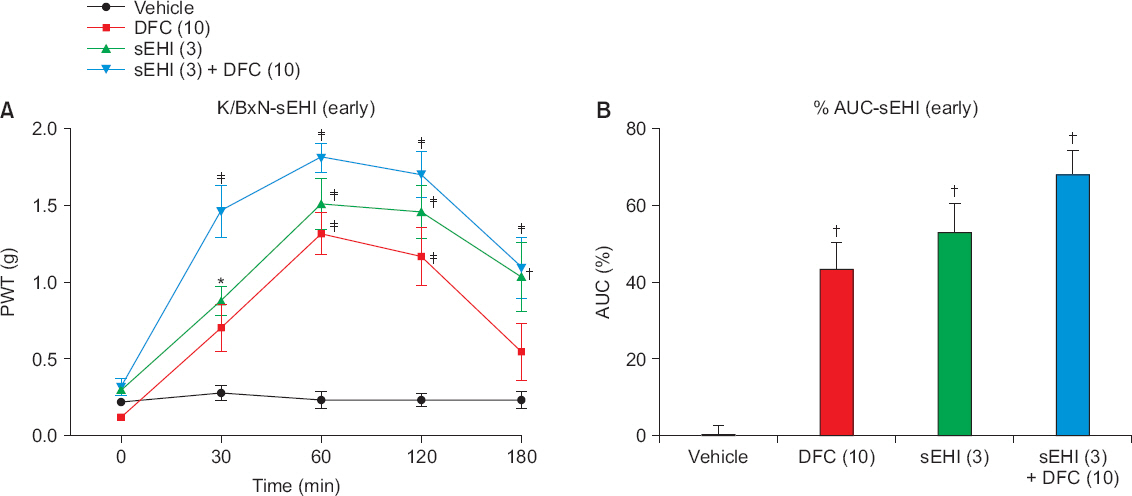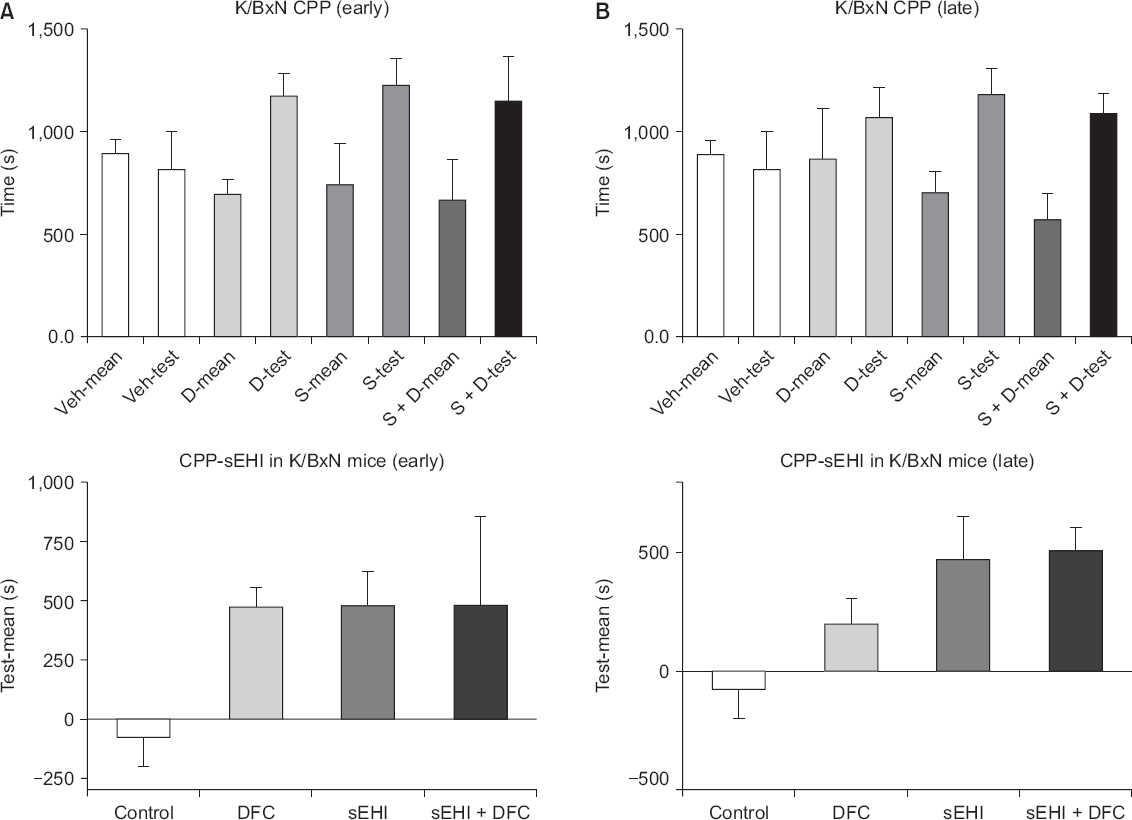Anesth Pain Med.
2019 Jan;14(1):76-84. 10.17085/apm.2019.14.1.76.
Analgesic effects of soluble epoxide hydrolase inhibitor in K/BxN serum transfer arthritis mouse model
- Affiliations
-
- 1Department of Anesthesiology and Pain Medicine, Incheon St. Mary’s Hospital, College of Medicine, The Catholic University of Korea, Incheon.
- 2Changwon Fatima Hospital, Changwon,.
- 3Seoul St. Mary's Hospital, College of Medicine, The Catholic University of Korea, Seoul, Korea. huejung@catholic.ac.kr
- KMID: 2434203
- DOI: http://doi.org/10.17085/apm.2019.14.1.76
Abstract
- BACKGROUND
Soluble epoxide hydrolase (sEH) is an enzyme that converts epoxyeicosatrienoic acid (EET) into the anti-inflammatory dihydroxyeicosatrienoic acids (DHET). Inhibition of sEH by the potent soluble epoxide hydrolase inhibitor (sEHI) decreases inflammation by increasing EET. The K/BxN serum transfer mouse model of arthritis displays an initial inflammation and an associated tactile allodynia that continues on following the resolution of inflammation.
METHODS
We undertook the following studies: i) Using the K/BxN mouse model, we examined effects on allodynia during the early inflammatory phase of administration of sEHI 3 mg/kg and/or diclofenac (DFC) 10 mg/kg. ii) In the late inflammatory phase, we administered sEHI (3, 10, or 30 mg/kg); DFC 10 mg/kg; gabapentin 100 mg/kg. iii) Using the conditioned place preference (CPP) we examined the synergism between sEHI and DFC in the K/BxN mouse using the CPP paradigm. The drug was administered intraperitoneally and the allodynia was measured with the von Frey test.
RESULTS
In the early phase, both sEHI and DFC displayed an antiallodynic action. In the late phase, sEHI, and gabapentin but not DFC were effective in reversing the allodynia. Comparable results were observed with the CPP.
CONCLUSIONS
This study demonstrates that sEHI reduces mechanical allodynia in both the early and the late inflammatory K/BxN mouse model of arthritis. The sEHI target thus addresses the hyperalgesia arising from inflammation as well as the post-inflammatory phase that has been said to reflect neuropathic-like states, thus presenting alternatives to the limited efficacy of arthritis drugs in use.
Keyword
Figure
Reference
-
1. Park HJ, Sandor K, McQueen J, Woller SA, Svensson CI, Corr M, et al. The effect of gabapentin and ketorolac on allodynia and conditioned place preference in antibody-induced inflammation. Eur J Pain. 2016; 20:917–25. DOI: 10.1002/ejp.816. PMID: 26517300. PMCID: PMC5986296.2. Bas DB, Su J, Sandor K, Agalave NM, Lundberg J, Codeluppi S, et al. Collagen antibody-induced arthritis evokes persistent pain with spinal glial involvement and transient prostaglandin dependency. Arthritis Rheum. 2012; 64:3886–96. DOI: 10.1002/art.37686. PMID: 22933386.3. Sufka KJ. Translational challenges and analgesic screening assays. Pain. 2011; 152:1942–3. DOI: 10.1016/j.pain.2011.04.028. PMID: 21550170.4. Inceoglu B, Bettaieb A, Trindade da Silva CA, Lee KS, Haj FG, Hammock BD. Endoplasmic reticulum stress in the peripheral nervous system is a significant driver of neuropathic pain. Proc Natl Acad Sci U S A. 2015; 112:9082–7. DOI: 10.1073/pnas.1510137112. PMID: 26150506. PMCID: PMC4517273.5. Spector AA. Arachidonic acid cytochrome P450 epoxygenase pathway. J Lipid Res. 2009; 50(Suppl):S52–6. DOI: 10.1194/jlr.R800038-JLR200. PMID: 18952572. PMCID: PMC2674692.6. Bystrom J, Wray JA, Sugden MC, Holness MJ, Swales KE, Warner TD, et al. Endogenous epoxygenases are modulators of monocyte/macrophage activity. PLoS One. 2011; 6:e26591. DOI: 10.1371/journal.pone.0026591. PMID: 22028915. PMCID: PMC3197524.7. Campbell WB, Gebremedhin D, Pratt PF, Harder DR. Identification of epoxyeicosatrienoic acids as endothelium-derived hyperpolarizing factors. Circ Res. 1996; 78:415–23. DOI: 10.1161/01.RES.78.3.415. PMID: 8593700.8. Chen J, Capdevila JH, Zeldin DC, Rosenberg RL. Inhibition of cardiac L-type calcium channels by epoxyeicosatrienoic acids. Mol Pharmacol. 1999; 55:288–95. PMID: 9927620.9. Christianson CA, Corr M, Firestein GS, Mobargha A, Yaksh TL, Svensson CI. Characterization of the acute and persistent pain state present in K/BxN serum transfer arthritis. Pain. 2010; 151:394–403. DOI: 10.1016/j.pain.2010.07.030. PMID: 20739123. PMCID: PMC2955775.10. Crofford LJ. Use of NSAIDs in treating patients with arthritis. Arthritis Res Ther. 2013; 15(Suppl 3):S2. PMID: 24267197. PMCID: PMC3891482.11. Jhun HJ, Ahn K, Lee SC. Estimation of the prevalence of osteoarthritis in Korean adults based on the data from the fourth Korea national health and nutrition examination survey. Anesth Pain Med. 2010; 3:201–6.12. Dennis EA, Norris PC. Eicosanoid storm in infection and inflammation. Nat Rev Immunol. 2015; 15:511–23. DOI: 10.1038/nri3859. PMID: 26139350. PMCID: PMC4606863.13. Dixon WJ. Efficient analysis of experimental observations. Annu Rev Pharmacol Toxicol. 1980; 20:441–62. DOI: 10.1146/annurev.pa.20.040180.002301. PMID: 7387124.14. Prus AJ, James JR, Rosecrans JA. Conditioned place preference. Methods of Behavior analysis in Neuroscience. 2nd ed. Buccafusco JJ, editor. Boca Raton: CRC Press;2009. p. 96–104.15. Xu X, Li R, Chen G, Hoopes SL, Zeldin DC, Wang DW. The role of cytochrome P450 epoxygenases, soluble epoxide hydrolase, and epoxyeicosatrienoic acids in metabolic diseases. Adv Nutr. 2016; 7:1122–8. DOI: 10.3945/an.116.012245. PMID: 28140329. PMCID: PMC5105036.16. Park HJ, Sandor K, McQueen J, Woller SA, Svensson CI, Corr M, et al. The effect of gabapentin and ketorolac on allodynia and conditioned place preference in antibody-induced inflammation. Eur J Pain. 2016; 20:917–25. DOI: 10.1002/ejp.816. PMID: 26517300. PMCID: PMC5986296.17. Mease P, Hanna S, Frakes EP, Altman RD. Pain mechanisms in osteoarthritis: understanding the role of central pain and current approaches to its treatment. J Rheumatol. 2011; 38:1546–51. DOI: 10.3899/jrheum.100759. PMID: 21632678.18. Mullin CA, Hammock BD. Chalcone oxides--potent selective inhibitors of cytosolic epoxide hydrolase. Arch Biochem Biophys. 1982; 216:423–39. DOI: 10.1016/0003-9861(82)90231-4. PMID: 7114846.19. Okun A, Liu P, Davis P, Ren J, Remeniuk B, Brion T, et al. Afferent drive elicits ongoing pain in a model of advanced osteoarthritis. Pain. 2012; 153:924–33. DOI: 10.1016/j.pain.2012.01.022. PMID: 22387095. PMCID: PMC3313555.20. Harder DR, Campbell WB, Roman RJ. Role of cytochrome P-450 enzymes and metabolites of arachidonic acid in the control of vascular tone. J Vasc Res. 1995; 32:79–92. DOI: 10.1159/000159080. PMID: 7537544.21. Kanellopoulos AH, Matsuyama A. Voltage-gated sodium channels and pain-related disorders. Clin Sci (Lond). 2016; 130:2257–65. DOI: 10.1042/CS20160041. PMID: 27815510.22. Liu CY, Lu ZY, Li N, Yu LH, Zhao YF, Ma B. The role of large-conductance, calcium-activated potassium channels in a rat model of trigeminal neuropathic pain. Cephalalgia. 2015; 35:16–35. DOI: 10.1177/0333102414534083. PMID: 24820887.23. Moini Zanjani T, Ameli H, Labibi F, Sedaghat K, Sabetkasaei M. The attenuation of pain behavior and serum COX-2 concentration by curcumin in a rat model of neuropathic pain. Korean J Pain. 2014; 27:246–52. DOI: 10.3344/kjp.2014.27.3.246. PMID: 25031810. PMCID: PMC4099237.24. Wagner KM, McReynolds CB, Schmidt WK, Hammock BD. Soluble epoxide hydrolase as a therapeutic target for pain, inflammatory and neurodegenerative diseases. Pharmacol Ther. 2017; 180:62–76. DOI: 10.1016/j.pharmthera.2017.06.006. PMID: 28642117. PMCID: PMC5677555.25. Iliff JJ, Wang R, Zeldin DC, Alkayed NJ. Epoxyeicosanoids as mediators of neurogenic vasodilation in cerebral vessels. Am J Physiol Heart Circ Physiol. 2009; 296:H1352–63. DOI: 10.1152/ajpheart.00950.2008. PMID: 19304946. PMCID: PMC2685348.26. Xu D, Li N, He Y, Timofeyev V, Lu L, Tsai HJ, et al. Prevention and reversal of cardiac hypertrophy by soluble epoxide hydrolase inhibitors. Proc Natl Acad Sci U S A. 2006; 103:18733–8. DOI: 10.1073/pnas.0609158103. PMID: 17130447. PMCID: PMC1693731.27. Norwood S, Liao J, Hammock BD, Yang GY. Epoxyeicosatrienoic acids and soluble epoxide hydrolase: potential therapeutic targets for inflammation and its induced carcinogenesis. Am J Transl Res. 2010; 22:447–57. PMID: 20733953. PMCID: PMC2923867.28. Marowsky A, Burgener J, Falck JR, Fritschy JM, Arand M. Distribution of soluble and microsomal epoxide hydrolase in the mouse brain and its contribution to cerebral epoxyeicosatrienoic acid metabolism. Neuroscience. 2009; 163:646–61. DOI: 10.1016/j.neuroscience.2009.06.033. PMID: 19540314.29. McLellan GJ, Aktas Z, Hennes-Beean E, Kolb AW, Larsen IV, Schmitz EJ, et al. Effect of a soluble epoxide hydrolase inhibitor, UC1728, on LPS-induced uveitis in the rabbit. J Ocul Biol. 2016; 4:10.13188/2334-2838.1000024. DOI: 10.13188/2334-2838.1000024. PMID: 28066796. PMCID: PMC5218821.
- Full Text Links
- Actions
-
Cited
- CITED
-
- Close
- Share
- Similar articles
-
- Epi-Leptosphaerin: A New L-Isoascorbic Acid Derivative from Marine Sponges
- Soluble Epoxide Hydrolase Inhibitory Activity from Euphorbia supina Rafin
- Interleukin 17-expressing Innate Synovial Cells Drive K/Bxn Serum-induced Arthritis
- Isolation and Structure Determination of an Imidazo-pyrimidine, 5-Chlorocavernicolin, Maleimide oximes and Nucleosides from a Marine Sponge Extract
- A New Paradigm for Pathogenesis of Rheumatoid Arthritis





